
This page got a little long so I've split it up into chapters for you to skip around.
2006, Original text
2018
2018 Retro Weekend
Jan 2019, disk imaging
Links, including the ESSG newsletters.
2018
2018 Retro Weekend
Jan 2019, disk imaging
Links, including the ESSG newsletters.
Original 2006 Text (Top)
I remember Exidy as being an arcade machine manufacturer that made 2 of my favourite games from the late 1970s,
'crash' and 'bandido'. With the former you had to avoid the computer controlled car that drove at you in the opposing direction while
you picked up the dots on the screen...hmm....remind you of pacman? The latter was a fantastic game with an 8-way firing joystick as well
as an 8-way moving joystick where you played a sheriff and had to rescue your love from mexican bandits.
The original Sorcerer dates from 1978 and has novel features that lifted it up and away from the likes of the Tandy
TRS80 Model 1 such as a user-defineable character set and a handy thing to have at the time - an S100 bus interface. It was also arguably
the first home computer to feature language ROMs in cartridge cases, in the case of the Sorcerer these were 8-track cartridge cases that had
been gutted and replaced with CBASIC ROMs on dedicated circuit boards. For the younger audience a quick google will tell you about 8-track
carts :o)
Mono video as standard, but the screen memory was split between ROM and RAM allowing a user defined character set
with a maximum resolution of 512x240, obviously this was a 'fake' resolution since the programmer could only redefine the 8x8 character cell
for each letter, similar to the CBM PET and other machines of the day.
The S100 bus was important because it was one of the first attempts at an industry 'standard' for expansion cards for
personal computers. Originally it came from the IMSAI and Altair home computers and was basically 100 electric connections for addressing,
data and power that allowed you do expand your machine with memory cards, disk controllers, video controllers etc. What was bad about it was
that various manufacturers had produced their own interpretations of the S100 bus so things weren't as compatible as they should have been.
The Sorcerer had a massive Australian push from it's primary electronics distributor, Dick Smith (who for once didn't
appear to rebadge the machine as one of their own, see the VideoGenie and Texet TX8000) and a big push in Europe from Compudata in
Holland who continued to make the machine under licence even after Exidy imploded in the early 1980s.
This machine, donated by Brendan Breen, has been tricked out quite impressively. As well as button-selective baud
rates for saving to cassette there's expanded memory and a pair of colour circuits from Stuart Micrographics that I've yet to find information
on. There's a stack of useful documentation as well as loads of ESCape magazines from the European Sorcerer Club. Best of all, it still
works :o)
Pictures
 |  |
2018 Update (Top)
With the 2nd Retro Weekend coming up at the Centre For Computing History in Cambridge I decided it was time to dig out the
Sorcerer again. As I wrote back in 2006 'it still works'. Well, will it still? Answer - nearly. After checking voltages from the linear AC lump
of a PSU I powered up and was greeted with random flickering garbage on screen. Better than nothing I suppose. Checking the 5V rail it
fluctuated between 4.4 and 4.2v which was far too low. Strangely for a machine like this there's a great big 8000uF capacitor right across the
5V rail and sure enough it tested as dead. Finding a similar replacement proved to be difficult so I got a slightly smaller form factor 10KuF
and soldered it in place. Result! A 'Supervisor' prompt. This appears to be a monitor nobody knows about.
Nothing much after that though. The BASIC cart didn't do anything and the display flickered. The usual Sorcerer monitor
ROM has a TEst command built in for checking RAM and this threw up a lot of errors. Was the RAM bad or was the BASIC ROMPAC bad? Checking the
memory map the BASIC ROMs live between 0xC000 and 0xDFFF so using the DUmp command I could see ROM contents right up to 0xDF00 where things went a
bit awry. 0xDF00 is in ROM 4 (0xD801 - 0xDFFF) so I burnt a new 2716 EPROM using an image from Dave Williams' Trailing Edge site and pondered how to
alter the cartridge so I could put pin 21 at 5V since the original PROM and replacement EPROM had a slightly different pinout. Exidy provided
cuttable traces to allow this but I didn't want to damage the board so took a 5V feed to a bent out pin 21 using the remains of a leg from a
capacitor.
Still no BASIC from the Sorcerer though. RAM tests were still failing too. As a precaution I burnt new 2716 EPROMs
with the stock Sorcerer Monitor just to make sure the replacement one in the machine wasn't corrupt. No difference so over to RAM. Rather than
check all 32 piggybacked chips I replaced all of them with 16 NOS spares. Result! The screen tearing had gone and I could get BASIC running.
This meant the only thing I could do was replace the piggybacked chips one by one until I found a fault. Bank 1 bit 1 was the first and
only failure. Thankfully the sellers of the original upgrade kit had provided spares ready made so it was an easy job to solder a new pair
into place.
All that was left after that was to clean up the S100 box, clean the edge connector of the disk controller within and
check voltages from yet another linear PSU. At first powerup the Sorcerer changed RAMTOP to 0xBBFF which is just below the start address of
the disk controller - 0xBC00. DUmping 0xBC00 to 0xBCFF showed recognisable data which was encouraging. After cleaning the heads of the
Micropolis drives I fed drive 0 a boot disk and.... it booted :D It booted to Micropolis MDOS though which is an OS I'd not heard of until
then. CP/M was more friendly and allowed a mandatory game of Space Invaders.
Pictures
 | 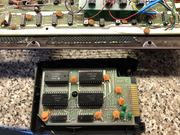 | 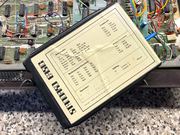 | 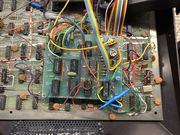 |
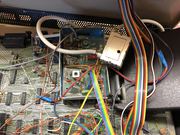 |  | 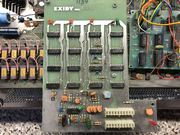 | 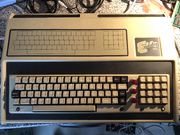 |
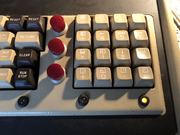 | 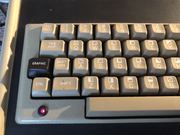 | 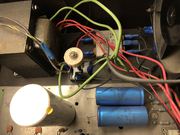 | 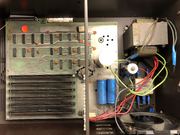 |
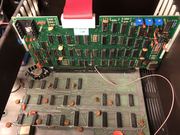 |  |  |  |
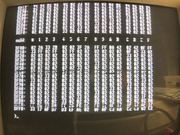 | 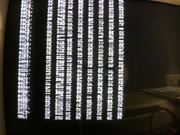 | 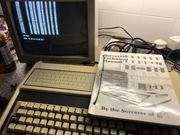 |  |
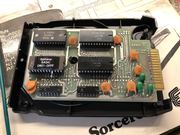 | 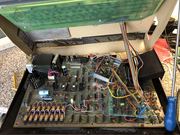 |  | 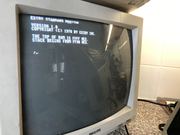 |
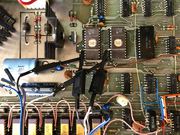 | 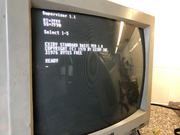 |  | 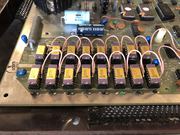 |
 | 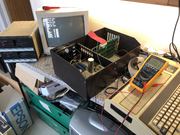 |  |  |
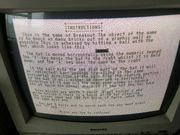 | 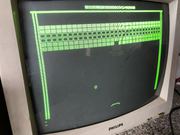 |  |  |
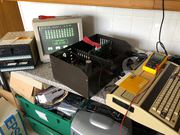 |  |  |  |
Sept 2018 update, Retro Weekend (Top)
The Sorcerer turned out to be a popular exhibit! I also discovered that the bottom drive in my Micropolis stack
wasn't well. Aside from that the machine ran flawlessly for two days, very impressive. For giggles I tried the colour output courtesy of the Stuart Micrographics colour
board that the original owner had fitted (and documented in the Sorcerer Newsletter) and it was...interesting. This colour board was designed for the
Nascom and UK101 machines but because it only requires D0-D7, power and clock signals it was crowbarred into the Sorcerer too. It can also output composite video so that's a
future thing to add.
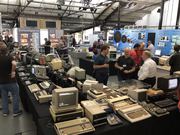 | 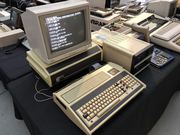 | 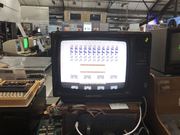 |  |
Post exhibition it was time to fix the dead bottom drive. Typically the available schematic doesn't match the seemingly rev B controller board fitted, but it's close enough for me to follow the 12V rail for drive 1 and discover it's dead. There's 3 regulators fastened to the massive heatsink on the back of the box, 2x 7812 (12V) and 1x 7805. (5V). The two 7812s power the drive mechanisms, 7805 is for the logic. I had a spare 7812 in an old project so fitted that and the bottom drive motor now spins with the top one, but try accessing it as drive B: from CP/M and it stops spinning as soon as the head drops. Checking voltages with the drive running show the 12V rail plummets to 4.9V while the head is accessed, but the positioner works on its own. The connectors are on long enough flying leads to allow me to run drive 1 as drive 0 if I completely dismantle the box so... Testing shows the mechanism, motors etc are fine - the Sorcerer will boot but put the mechanism back as drive 1 and it all stops again. On a whim I ordered some new 7812s.
After a few days' break away from all things 8-bit I came back to find my little package had arrived. I'd left
everything in bits so fitting the replacement in the Micropolis PSU was a relatively quick job. Powering up with a pair of DMMs on 12V
and 5V showed that the voltages stayed stable when the floppy drive head was selected. It also booted CP/M off the bottom drive for the
first time! I reassembed the whole unit (and remembered to flip the drive addressing back again) and got a clean boot from drive 0 with
a good read of drive 1.
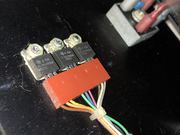 | 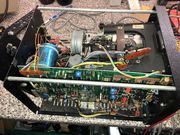 |  | 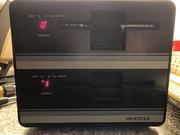 |
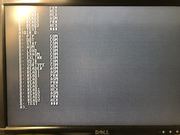 |  |  |  |
Links (Top)
A good writeup on the history of Exidy is here
Issues 14-20 of the ESSG newsletters are here (10MB download)
Issues 14-20 of the ESSG newsletters are here (10MB download)
Greaseweazle images of floppies from a Liveport FDM180 drive are here